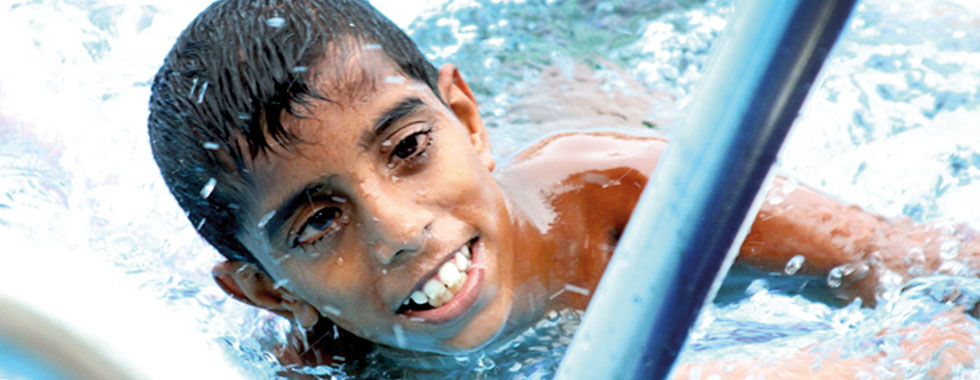Here a splash, there a splash: Unseeing eyes take the plunge
Swimming coach Chithra Malalasekara shares the wonder of teaching visually handicapped children under CandleAid’s Swim for Safety programme
When she knew she would be coaching blind children, one of the first things Chithra Malalasekara did was to get into the pool blindfolded. She realised immediately that direction was an issue – she frequently found herself disoriented in the water. So she asked Capt. Elmo Jayawardena, founder of CandleAid Lanka, to get her some kind of bell. However, despite all the materials she studied and the plans she put in place to teach the children, she’s found that her students are perhaps her best teachers. She’s learned to rely on their instincts and the little tricks they use to navigate a world designed for those with sight. Her coaching style is quite different from the tack she uses with the sighted kids but four weeks into the programme, one thing is clear – it’s working. “They’re lovely children,” she says.

‘Water babies’ having a great time and below Mrs. Malalasekara gives a guiding hand. Pix by M.D. Nissanka
Mrs. Malalasekara has been with CandleAid’s Swim for Safety programme for five years now and has trained over 5500 children with a pass rate of 96.1%, which this programme’s chief coordinator Sameera De Silva hails as a “remarkable achievement”. When we visit the beautiful CandleAid pool at St. Sebastian’s College in Moratuwa, the children are just getting ready to dive in. Depending on how confident they’re feeling, some are using long, multi-coloured noodles, the newcomers are clinging determinedly to the ledge, while one or two of the old hands have progressed beyond breaststroke and into freestyle.
Harshana Nilipul Naiyanapriya is one of them. He first began swimming at age 16 and is now nearly 18 but this is the first time he’s receiving proper training. He says he’s enjoying the size of this pool – it’s the biggest he’s ever been in. By gently directing his hands and allowing him to feel how her own move, he says Mrs. Malalasekara is helping him master the freestyle. Though she’s the only one in the water today, the pool is surrounded by volunteers – people who have offered ‘an extra pair of eyes’ to watch over the kids as they learn. There’s also a lifeguard tracking each swimmer’s progress.
Hasantha de Silva, a house master from the School for the Blind in Ratmalana shepherds his charges over here every Tuesday and Thursday for a two hour session. “I call them water babies,” says Mr. de Silva, “they’re like ducks, they don’t want to leave the pool.” They have a much smaller pool at the school, so this is a chance for these children to learn proper technique, something Supun Jayasooriya says he’s particularly enjoying. Mr. de Silva also introduces us to W.E.M. Thilina Madhushan, a partially sighted child who has already done a few laps before he speaks to us. He’s less afraid of the water because he can make out the edges of the pool, says Thilina. When asked what he enjoys most about these classes, his response is almost poetic – liberty, he says.
Ten-year-old Subaharan is the youngest in the pool today. To fund him, three little children sacrificed their ice cream for a month, says Sameera explaining that funding for the disabled abled swimmers (DAS) programme has come primarily from Brussels and Singapore. “They are mainly schoolchildren who collected money to donate so that differently abled children can swim,” he says. The DAS programme is an extension of the Swim For Safety project which was started in 2007, a response to the number of children who died in the tsunami who might have been saved if they only knew how to swim. Currently 10 blind students are enrolled in the programme and the next batch will be made up of 10 deaf students (among whom there will also be girls). “At the moment all the blind students are progressing well and I am sure they will swim 25m before 8 days training,” says Sameera.
Though this one is doing well, Mrs. Malalasekara is nervous about the next batch of children – she thinks that deaf students will bring with them challenges specific to their disability. However, she believes that success will come if she can earn their trust. It’s what has her so closely bonded to her current batch of students: “They trust me,” she says. “The first thing is if they trust us they’re doing all the things we say.” She’s also realised that her students can see – albeit in a very different way. Their heightened senses allow them to learn from touch and sound alone. A teacher of maths at the Prince of Wales College in Moratuwa, Mrs. Malalasekara joined as a volunteer, now she says the love she feels coming from her pupils is the best reward for all their effort.
Recalling his own experiences of learning to swim and how it left him feeling more capable and on an equal footing with his peers, Sameera says he imagines the blind students feel much the same way. His satisfaction comes from the idea of CandleAid being “the rope between blind’s and normal children’s worlds.” Much of what CandleAid accomplishes is thanks to the volunteers like Sameera who subscribe to the group’s motto: ‘It is better by far to light a solitary candle than to curse the darkness.’ “This is the first time in Sri Lanka this kind of a project is happening,” he says, adding, “We lit a candle with this project.”
For more information visit CandleAid’s website www.candleaid.org or call on 94-11-2642526.
Follow @timesonlinelk
comments powered by Disqus


